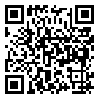BibTeX | RIS | EndNote | Medlars | ProCite | Reference Manager | RefWorks
Send citation to:
URL: http://ppj.phypha.ir/article-1-1369-en.html
Introduction: To study the effect of withdrawal syndrome in morphine-dependent male rats. Methods: Adult male rats were divided randomly into four groups: control (G1), received morphine (G2), received morphine and treated by clove (G3) and only treated by clove (G4). The rats were administered increasing doses of morphine (0.1, 0.2 and 0.3 mg/ml), each dose being administered for two days, and then a dose of 4 mg/ml was given every day for 21 consecutive days. After the last oral dose of morphine on day 21, the rats were treated daily with oral clove (4 mg/ml/kg) for 14 days. Following the treatment, the histological parameters, oxidative stress, LH, FSH and testosterone levels were measured. Results: The histological parameters were not significantly changed. In the morphine group, it was observed that the levels of LH, FSH and testosterone decreased significantly in comparison to the control group and clove treatment could significantly increase the LH, FSH, testosterone, glutathione peroxidase and superoxide dismutase levels in G3 groups. Also, the level of malondialdehyde (MDA) increased significantly in the morphine group and treatment with clove could significantly decrease the MDA level in G3 groups. Conclusion: Our results showed that the hormone levels (LH, FSH and testosterone) and antioxidant enzyme increased with the administration of clove after morphine withdrawal. This may be because of the antioxidant effect of clove or the direct effect of this plant on the hypothalamic–pituitary–gonadal axis, or both.
| Rights and permissions | |
 |
This work is licensed under a Creative Commons Attribution-NonCommercial 4.0 International License. |






